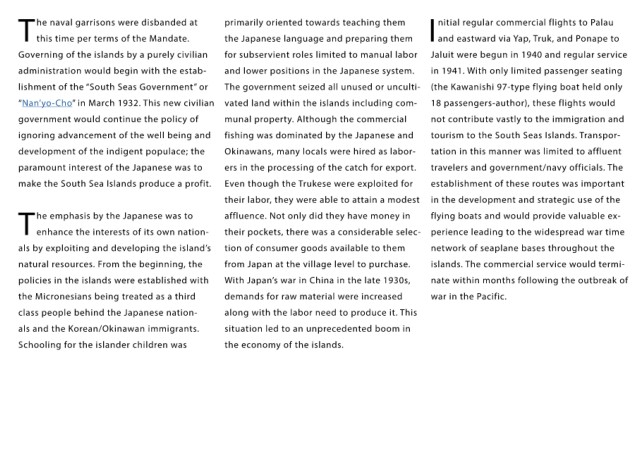Page 151 - Micronesia
P. 151
he naval garrisons were disbanded at primarily oriented towards teaching them nitial regular commercial flights to Palau
the Japanese language and preparing them
T this time per terms of the Mandate. I and eastward via Yap, Truk, and Ponape to
for subservient roles limited to manual labor Jaluit were begun in 1940 and regular service
Governing of the islands by a purely civilian
administration would begin with the estab- and lower positions in the Japanese system. in 1941. With only limited passenger seating
lishment of the “South Seas Government” or
“Nan’yo-Cho” in March 1932. This new civilian The government seized all unused or unculti- (the Kawanishi 97-type flying boat held only
government would continue the policy of
ignoring advancement of the well being and vated land within the islands including com- 18 passengers-author), these flights would
development of the indigent populace; the
paramount interest of the Japanese was to munal property. Although the commercial not contribute vastly to the immigration and
make the South Sea Islands produce a profit.
fishing was dominated by the Japanese and tourism to the South Seas Islands. Transpor-
T he emphasis by the Japanese was to
enhance the interests of its own nation- Okinawans, many locals were hired as labor- tation in this manner was limited to affluent
als by exploiting and developing the island’s
natural resources. From the beginning, the ers in the processing of the catch for export. travelers and government/navy officials. The
policies in the islands were established with
the Micronesians being treated as a third Even though the Trukese were exploited for establishment of these routes was important
class people behind the Japanese nation-
als and the Korean/Okinawan immigrants. their labor, they were able to attain a modest in the development and strategic use of the
Schooling for the islander children was
affluence. Not only did they have money in flying boats and would provide valuable ex-
their pockets, there was a considerable selec- perience leading to the widespread war time
tion of consumer goods available to them network of seaplane bases throughout the
from Japan at the village level to purchase. islands. The commercial service would termi-
With Japan’s war in China in the late 1930s, nate within months following the outbreak of
demands for raw material were increased war in the Pacific.
along with the labor need to produce it. This
situation led to an unprecedented boom in
the economy of the islands.

